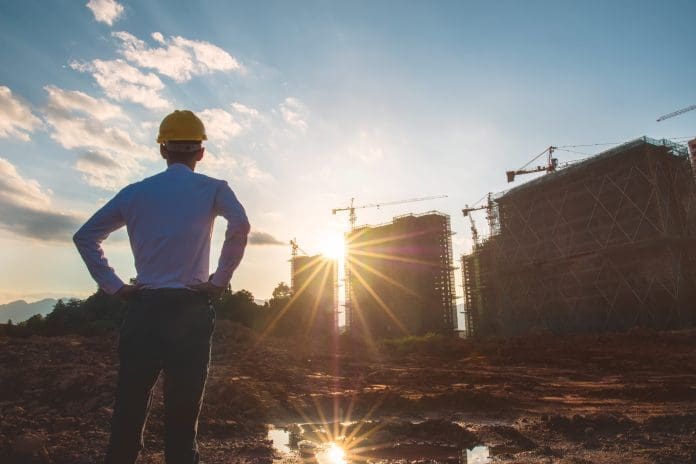Net zero, the skills shortage, RAAC, extreme weather, infrastructure opportunities and tool theft- there’s plenty to watch out for in construction in 2024
As 2023 is consigned to the history books, the construction industry has turned towards the coming year, and predictions are coming thick and fast about what 2024 will hold.
Whether it’s through new regulations to improve building safety or re-focus efforts towards Net Zero 2050, the sector is no doubt undergoing significant change.
Sustainability was a focal point of 2024 construction predictions
Russell Haworth, CEO, NBS & Glenigan, did not mince his words: “Sustainability will be front and centre in 2024. It’s no exaggeration to say we’re now facing the biggest crisis of our lifetimes and with construction responsible for a quarter of UK emissions, there needs to be a focus on the four Cs: climate, carbon, compliance, and cost.
“Linking these together will be the ever-growing need for data and transparency. As the financial system becomes more aware of climate risk and carbon costs, I predict this will push construction to become greener. Soon projects will be uninsurable and unable to secure loans without robust evidence of their green credentials.”
A focus on energy consumption is set to be prominent in the new year
Jennifer Thomson, CPO, MachineMax, shared the sentiment: “The focus on energy consumption, especially within sectors like heavy machinery, is set to be prominent in the new year. To effectively implement solutions for emission reduction, there must be a greater emphasis on adopting a robust benchmarking approach.
“As the industry continues to digitise its processes, the ability to understand the emissions that are being generated and how efficiency can be improved is critical but also more readily available than ever before.
“Closer monitoring of machine metrics is one easy-to-grasp solution that should take shape, allowing companies to correctly identify operational efficiencies throughout all stages of a project – knowing how and when machines are being used can make a big difference in fuel consumption.”
“We’re leaving 2023 still behind in the fight against climate change, and time is now finite. If we’re to futureproof our environment, then delivering a joined-up strategy is vital. This begins with the monitoring and management of machinery and carbon measuring frameworks.”
The skills shortage continues to put pressure on the industry
Adrian Attwood, executive director of DBR (London) Ltd, said: “Investing in skills needs to become a priority for the UK construction sector, particularly in specialist professions. Niche roles from conservation stonemasons and master joiners to leadworkers, gilders, and even cleaners are at significant risk as talent pools continue to shrink.
“With the economy starting to stabilise and an upcoming election providing an opportunity to press the reset button on the education system, I hope that policymakers and the industry can come together to develop a deliverable strategy to overcome the acute human resource shortages we’re currently experiencing.”
Sean Keyes, CEO of Sutcliffe: “As the cost of university education rises, I anticipate that more Gen Z’s will realise that a personal debt of £50,000 to obtain a degree will never be repaid, leading to a rise in apprenticeships for school leavers. I believe degree apprenticeships are the future, and these should be fully funded by the Government with similar schemes to bring those out of unemployment and into the workplace.
Collaboration and stronger networks will help avoid economic peril
Simon Herod, international lead at EstimateOne, said that he hoped “-to see main contractors placing a far greater emphasis on building a robust network of subcontractors. The importance of this cannot be overstated; it plays a pivotal role in addressing uncertainties that may arise. This has been particularly evident this year, with a significant increase in the number of contractor insolvencies.
“Trust will remain a cornerstone in subcontractor relationships going into 2024, underscoring the need for validation and collaboration from the get-go, particularly during the quoting stage. For main contractors, ensuring the financial stability of these partners is paramount, significantly reducing the risks associated with the competitive landscape of tendering.
“Diversifying networks will also emerge as a strategy to ensure economic resilience. Main contractors must consider connecting with a greater number of subcontractors to enable them to successfully expand their services, and venture into new sectors and regions, whilst nurturing their existing networks. This approach will bolster resilience in the face of inflation.”
As cost of living pressures continue, crime is likely to follow
Alexis Potter, managing director of BauWatch UK, warned that criminals are utilising new and innovative methods to commit tool theft.
“Research in our upcoming Cost of Crime report indicates that crime has not only increased in 2023 but six in ten people (60%) feel it has also become more sophisticated. This echoes reports in 2023 from farmers that drones and social media are now being used to “scope out” farms before vehicles and equipment are taken.
“When viewed in isolation, it’s easy to underestimate the impact of theft on construction sites. But costs from delays or tool replacement soon add up, and this has the potential to make it harder to meet project deadlines.
Construction projects always operate on paper-thin margins – and a small incident can have an outsized impact. With the cost of living crisis and goods inflation making construction sites more vulnerable, firms must be able to protect themselves against what’s to come.”
Regulation is likely to increase- but it should not be seen as the enemy of innovation
Christian Mabey, managing director, Optima Products, said: “In 2024 core focus will be placed on one of the building product community’s thorniest issues: virgin material consumption. Despite the endeavours of various national Governments to drive down consumption, levels remain high, resulting in more waste and higher emissions.
“As manufacturers, we have a social responsibility to lead the way towards overcoming this long-standing problem. A good starting point will be making a firm commitment to circular practices and encouraging others to do the same.
YES, REGULATION IS GETTING TIGHTER, BUT NONE OF US SHOULD BE STANDING AROUND WAITING TO BE SWEPT ALONG.
“Significant improvements can be made by implementing small, incremental adaptations now, such as prioritising reuse or recycling over new production. Getting these approaches in place now will aid and prepare us for larger, more transformative changes down the line.”
Infrastructure’s profile will stay topical after the HS2 and RAAC fallout
Steve McSorley, director of Perega, warned that: “RAAC will remain a topical issue as more public and private verticals fall under the microscope, with prisons being the latest. It represents a challenge and opportunity for structural engineers nationwide, not only to remediate a longstanding problem, but also display technical expertise and use the latest approaches to come up with forward-thinking solutions to keep these buildings standing.
“Elsewhere, it will be about futureproofing the built environment. 2023 has seen the weather becoming more erratic and a sizable task will be adapting existing assets to withstand harsh elements, including increased instances of flooding and drought.”
New opportunities are on the horizon for 2024
“There will be plenty of opportunities for infrastructure development and enhancement in 2024. Ongoing projects such as the new Thames Crossing, HS2 Phase 1, and Hinkley Point C will keep many civil engineering firms busy in the new year,” said director of UK engineering at Ayesa, Rob Sizer. “Whilst the cancellation of HS2 Phase 2 is a temporary air pocket in the pipeline, the funds freed will likely be diverted to new work in the North, including road and rail upgrades.
“Furthermore, the Free Ports programme, acceleration of renewable energy provision, and extensive brownfield remediation point to a much-needed uptick in construction activity over the coming 12 months.”














